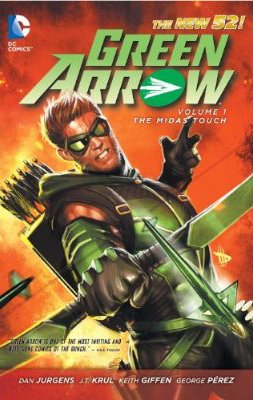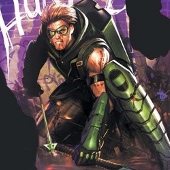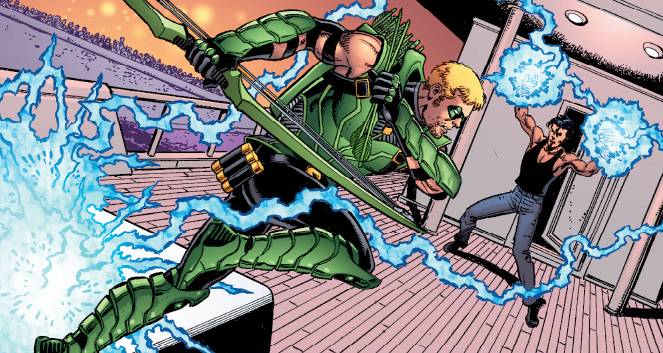Review: Green Arrow Vol. 1: The Midas Touch
 The Emerald Archer makes his makes his New 52 debut! Fighting baddies, dealing one-liners, bringing justice in…not-so-spectacular fashion.
The Emerald Archer makes his makes his New 52 debut! Fighting baddies, dealing one-liners, bringing justice in…not-so-spectacular fashion.
Like most casual comic book fans, my greatest exposure to Green Arrow comes from the Justice League Unlimited animated series where, in one of the series’ more climactic episodes, GA describes himself as “an old lefty” who believes that “governments should do for their people what they can’t do for themselves.” Ever since, I’ve had a particular fondness for the character and his leftist brand of justice. Unfortunately, DC hadn’t been kind to old Ollie Queen pre-reboot. The events of Cry for Justice more of less demolished the character in the eyes of the DC universe’s fictional populace as well as the eyes of fans. So if there’s any character out there who could benefit from a reboot most, it’s Green Arrow.
Unfortunately, that leads us to the question of what Green Arrow has been rebooted into. Where once Oliver Queen crusaded the streets of Star City in the name of arch liberal social justice, now he’s back to running Queen Industries, specifically a division called Q-Core, developing gadgets and other social media tech, such as the Q-Phone and the Q-Pad (I guess the all-caps typestry discouraged qPhone and qPad, or maybe that’s just too on the nose). Meanwhile, Oliver stalks the rooftops of Seattle, WA (yeah, no more Star City, it seems), as Green Arrow, confronting villainy at every turn…or more often reacting to villains on the attack. We actually see remarkably little of Green Arrow’s supposed heroics. The only person he seemingly saves throughout the course of the book is a supporting character working for Queen Industries. No innocent bystanders. No anonymous damsels in distress. Not even the old child trapped in a burning building routine. Sheesh, I didn’t know Seattle was so crime free.
Ollie himself has had a de-aging treatment down to his mid-twenties, much less the grizzled old lefty and much more the hipstery douchebag. Honestly, I’m surprised he didn’t show up in sandals at one point, or maybe loafers without socks and skinny jeans. Also, Ollie’s signature Vandyke has been nixed for a layer of perma-stubble.
Obviously, this reinterpretation…bothers me, to say the least, but we’ll save that for later. For now, the synopsis.
For this trade we have two relatively separate stories divided between the first and second halves of the book. The first story follows Green Arrow’s encounters with a group of hip, new, “modern” supervillains who film their crimes and post them on YouTube. Naturally…well, actually, it’s not natural at all but the book pretends that it is so we readers just have to follow along…this makes them huge internet celebrities with millions (yes, millions) of followers and supporters. Thus, the Emerald Archer, once the hunter, now becomes the…Wait, really!? The “hunter becomes the hunted” schtick? That’s not even my language, Dave Wilkins’ cover for issue two literally has the words “the hunted” graffitied above Green Arrow’s head!
The second story features the titular Midas whose “touch” indeed poses quite the threat to Green Arrow. This is more your typical Good Guy vs. Bad Guy scenario and, frankly, it’s not much to speak of. This wouldn’t be such a bad thing if only some character had been injected into the story. But no, Ollie’s one-liners fall flat, many of the jokes are stale, and the banter between hero and villain feels tired and lifeless. In the end, it’s all a matter of GA figuring out which trick arrowhead works best against the unstoppable abomination and it all ends as you’d expect.
J.T. Krul writes Green Arrow as if he’s writing Iron Man, and that has to be one of the weakest points of the book. In fact, there’s a scene where Oliver’s Pepper Potts-esque secretary walks in on him in his office while Ollie’s quickly undressing from his GA uniform. What follows is a near beat-for-beat exchange mimicking a scene from the first Iron Man film where Pepper Potts walks in on Tony Stark unequipping his armor — Ollie even paraphrases the “You’ve walked in on me doing worse” line. Green Arrow had his flirty moments, especially around Black Canary, but he was no playboy (certainly no Tony Stark).
In fact, this entire volume of Green Arrow actually reminds me specifically of Iron Man: Extremis where Warren Ellis reintroduced Tony Stark for the modern tech age. The remarkable thing about that book was how Ellis played off very specific minute details surrounding the true stories of modern tech companies and wove them into the narrative of Extremis (for those who have read that book, I’m thinking specifically of the scene where Tony and Maya Hansen speak with their old mentor Sal Kennedy). The minutiae, of course, expands the narrative, makes the world feel bigger than it is; this simply isn’t a story about Iron Man, but about Iron Man’s place in the grander scheme of things — technological advancement, man-machine integration, social evolution in an age of continuous advancement, upgrades, and change. And, of course, about Tony’s own sense of self-worth. For all Krul does to make Q-Core look like the DC universe’s Apple Computers, it lacks that attention to detail, that specificity, that makes the obvious parallels meaningful.
The only thing that makes Green Arrow fit into a larger world is the inexplicable relocation of Green Arrow to Seattle, Washington, which is immediately undone when Krul utterly fails to capture the Seattle atmosphere. It’s just another generic metropolis here. Shit, I know it’s a stereotype, but every damn outdoor panel of the this comic has a clear blue sky. In Seattle. Seattle, Washington! One of the rainiest cities in entire United States! The only thing Seattle here is the Space Needle that pops up in the background at random intervals.
As well, the opening narrative about Green Arrow battling social media savvy villains falls well short of making any kind of meaningful point. It’s basically a watered down Natural Born Killers without the visual flair, biting satire, or panache. In fact, it borders on outright condescension when at one point one of Ollie’s cohorts, Naomi, places video games as a point on the slippery slope to watching snuff films where supervillains beat heroes to death. Seriously!? This old chestnut? Christ, you gotta be kidding me. Although I shouldn’t be surprised: the book begins with this little bit of “satire”: “Goodfellas are cool. Pirates are sexy. Hit men are kickass” as part of Green Arrow’s screed against the public’s glorification of such characters in the media, supposedly leading to the glorification and acceptance — even admiration of — supervillains in DC’s version of “real life.” Call me an optimist, by I have more faith in humanity than that, especially the sort of humanity occupying the DC universe. Civilians in Marvel Comics will turn on their heroes at the drop of a hat, but DC civilians know their heroes are good and just and deserving of their admiration (or at least they used to). Even in real life, everyone has a morbid curiosity — we all slow down at the sight of a wreck on the side of the highway — but only a fleeting minority, I would imagine, would flock to this kind of snuff perversion. Not that this sort of premise can’t work (it worked well enough in Natural Born Killers), it’s just so heavy-handed here that it’s impossible to take seriously in either a real or fictional context.
On the matter of visual flair and panache, there’s nothing really remarkable to look at here. Pencils by Dan Jurgens prove serviceable but far from interesting, they fail to bring anything unique to the story being told beyond bringing Point A to Point B. Ignacio Colero takes over for issue six and, immediately, all the panels are at least more dynamic in their framing and progression than in previous issues but the shift in art style only highlights how typical and uninteresting the story being told truly is.
The upside here, Krul leaves after issue six of Green Arrow and the following story arc is handed to Annie Nocenti and, wow!, I’ve never seen a book improve so much in a single issue before. The dialogue is crisper and livelier (though GA does seem to monologue a bit too much at times); she actually takes the Oliver Queen-as-playboy idea, runs with it, and makes it interesting; pencils by Harvey Tolibao are far more interesting than anything in The Midas Touch and much less reliant on heavy black inks, making it a far more colorful book; and issue seven has single-handedly convinced me to stick with the series despite how bland the first six issues came out. I would recommend this book as a starting point for what looks like what could be a really fun run with Nocenti and Talibao, but, honestly, issue seven hold up well enough on its own that you don’t really need this volume to introduce you to Green Arrow.
Hold out for volume two.


